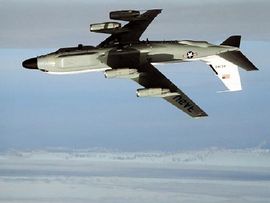RC-135
The RC-135 or "Flying Pig" is a fast and versatile military jet aircraft. The RC-135 is employed by the United States Air Force. However, it has given its two-week notice. The RC-135 has an excellent take-off to landing ratio of 3:1 and has been known to occasionally rear-end an F-16 being piloted by some old lady on her way to the supermarket or church.
Configurations[edit | edit source]
The RC-135 exists in many mission-specific configurations:
RC-135-XT[edit | edit source]
This was the original model, with the big red toggle switch on the side. It carried equipment for strategic reconnaissance and was distinguished by the dual "Mae West" radomes. When this baby went "Tits Up," it gave new, literal meaning to the term.
RC-135-AT[edit | edit source]
This advanced model was refitted with additional command and intelligence equipment. For example, it could hold a complete phone bank. During the First Gulf War, enlisted men used these facilities to telephone everyone in Kuwait to ask them to go to the polls and vote against Saddam Hussein's conquest of the country.
The RC-135-AT models were engineered to meet evolving environmental requirements. They were built entirely without asbestos; in addition, their miniature models can be built with a minimum of polystyrene glue, which at the time was increasingly being huffed for psychoactive effect. The RC-135-AT models were deconfigured and decommissioned and became Officer's Lounges at many domestic Air Force bases.
RC-135-Mk II/Stacey Jane[edit | edit source]
Originally designated RC-135-P2 but given the project name Stacey Jane after a memorable late evening at a Tailhook convention, this aircraft was fitted with a phased-array radar system with the sole mission of detecting life, or at least broadcast television, originating outside our solar system. The radar system weighed over 35,000 pounds and was one reason the aircraft never achieved take-off and performed its mission on an unused taxiway at Palin AFB in Alaska. The enormous power requirement for the radar system was satisfied by revving up the engines with the brakes engaged; the heat dissipation requirement was met by opening all the windows and was one reason for the choice of Alaska as the aircraft's base. This model remains in active operation, as there is nothing else that can be done either with it or with the taxiway on which it sits.
RC-135-P3 Sedan Chair[edit | edit source]
The RC-135-P3 was fitted with additional COMINT capability and tasked to monitor the border with Mexico. An additional radio antenna was installed in a specially configured bent nose, by which the aircraft can be identified, as can many of its reconnaissance targets. Sedan Chair was destroyed in a landing accident, as it "dropped the Chalupa" well short of Runway 33E in Mexicali.
RC-135-XP Lawn Jockey[edit | edit source]
The RC-135-XP was an RC-135 ordered with "the Works," or all COMINT, FUBAR, SNAFU, and signal processing equipment installed on all predecessor models. The aircraft was equipped with 14 jet engines, including 2 on the rear stabilizer fin, to both power the equipment and achieve takeoff.
The mission for the Lawn Jockey is to fly unobtrusively over battle theaters such as Afghanistan and operate the Predator drones that eliminate selected military targets, while sparing most of the small children, cute kittens, and endangered species they carry in their entourage with which to deploy instant post-mortem guilt trips on Coalition forces. The mission assumes the President elects to interrupt his golf game and declines to order the Air Force to bring in the target for gentle questioning by Public Defenders.
RC-135-PX Red Squirrel[edit | edit source]
Chronic stability problems with the RC-135-XP were addressed on one aircraft, designated the Red Squirrel, by mounting the jet engines on the rear stabilizer fins backwards. The design goal was that, much as a squirrel's rear claws grip upward during climbing, having the forward engines thrust forward while the aft engines thrust backward would counteract the excessive yaw, pitch, and wobble in the unmodified version. Test flights of the Red Squirrel are conducted on a volunteer basis, in view of the current absence of conscription for the U.S. armed services. To date, there have been no volunteers.
Crew training[edit | edit source]
The crew of the "Rivet Joint" have the reputation as the most highly qualified and educated members of the Air Force. This reputation is hard-earned through trial-by-fire in numerous technical schools. From day one the Airmen are barraged with a mountain of dreaded "Computer-Based Training" (known colloquially as "CBT"). These grueling training sessions lead to an attrition rate of over 90%, as most Airmen simply cannot handle quarterly JFIC training, bi-annual "mountain gorilla fecal analysis training" and annual computer-based training on "How to accomplish computer-based training." The largest obstacle to the successful completion of the qualification training comes not from CBT but rather the feared reflective belt confidence course. Crewmembers' final exam is to demonstrate their ability to properly display their reflective belts in a number of challenging situations.




